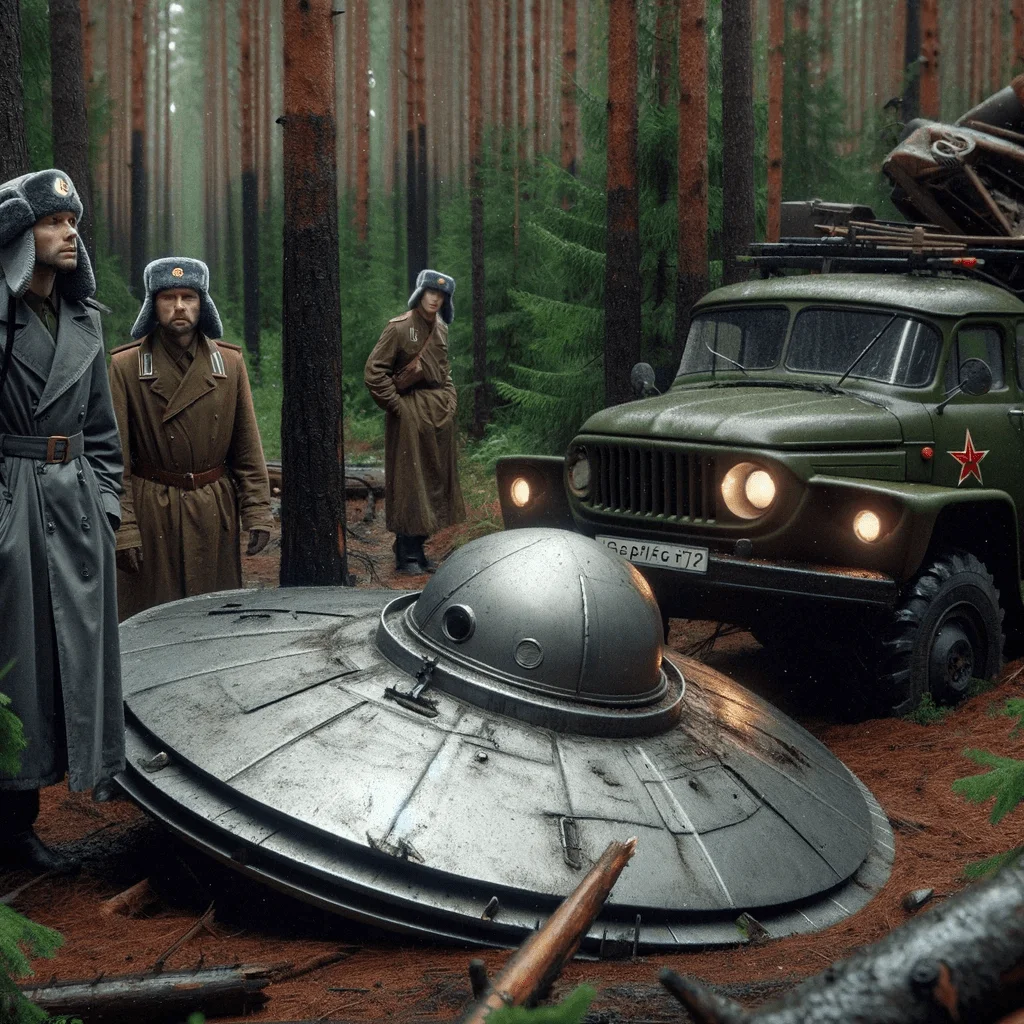Berezovsky, Region of Sverdlovsk, Russian Federation Crash (1969)

In the vast wilderness of Berezovsky, a town nestled in the Ural Federal District of Russia, an unusual event had reportedly unfolded in 1969. A UFO, purportedly crashed and stranded in the dense forests surrounding the town, has garnered attention, not only due to its extraterrestrial implications but also the unusual response by the Russian military. This article explores the validity of this incident through the lens of various details, mainly focusing on the unmistakable presence of the Russian military and how they looked in 1969.
Berezovsky is a town in the Sverdlovsk Oblast region of Russia. Sverdlovsk Oblast is situated in the Ural Federal District, straddling the border between the European and Asian parts of Russia. The region is rich in resources, including minerals and metals, and plays a crucial role in the Russian economy.
Berezovsky is known as one of the oldest mining settlements in the country. Founded in the early 18th century, it has a long history of gold and platinum mining. The town’s mining and metallurgical industries continue to play a significant role in its economy today.
The town is relatively small in population, with the number of residents being in the tens of thousands.
Forested Areas
Berezovsky, is known for its significant forested areas. The region is part of the larger Ural Mountain range, which boasts a considerable amount of forests. These forests are primarily composed of Siberian spruce, Scots pine, Siberian larch, and silver birch. They provide a habitat for various wildlife and serve as a resource for the logging industry.
Soviet-era Greatcoat (Shinel)
The soldiers are wearing the Soviet-era greatcoat (Shinel), a long, heavy, and typically woolen overcoat that often reached down near the wearers’ boots. This overcoat, which was a common part of the Soviet winter uniform, indeed has a belt or strap at the waist, and was used widely in the Soviet military, including in the 1960s.
Ushanka Hat
In the Soviet Union’s winter conditions, soldiers typically wore the “ushanka” hat. This is a fur cap with ear flaps that can be tied up to the crown of the cap, or tied at the chin to protect the ears, jaw, and lower chin from the cold. These hats were often made of sheepskin, rabbit or muskrat fur, or wool.
During the 1960s, a badge displaying the Soviet Red Star, hammer and sickle, or the Red Army’s star might be seen on the front of the hat, providing a clear indication of its military origin.
The GAZ-69
The GAZ-69 was a four-wheel drive light truck that was produced by GAZ (Gorkovsky Avtomobilny Zavod), which translates to Gorky Automobile Plant, located in Russia. Production started in 1953 and the model was produced until 1955 by GAZ, but continued to be produced until 1972 by UAZ, as well as several other manufacturers outside of the USSR.
The GAZ-69 was developed to replace the earlier GAZ-67 model, and it was built to be rugged, reliable, and easy to maintain. It was primarily used for transporting troops and cargo, but it was also used in several other roles, such as a light artillery tractor or as an ambulance. The vehicle was powered by a 55-horsepower 2.1-litre inline-four engine.
The design was simple and robust, with a high ground clearance for off-road use, and a sturdy frame for carrying heavy loads. The GAZ-69 could seat up to eight people, including the driver, with bench seats in the cab and in the back. It also featured a canvas top that could be folded down.
Despite its simple design, the GAZ-69 was known for its excellent off-road capabilities. It had a part-time four-wheel drive system, meaning the driver could engage or disengage the four-wheel drive as needed. The vehicle also had a two-speed transfer case, providing both high and low range gears for different driving conditions.
The GAZ-69 was widely exported and was used by many militaries around the world. Its simplicity, reliability, and off-road capabilities made it a popular choice for both military and civilian use in many countries.
It should be noted that the GAZ-69 and its versions were produced for many years after 1955 by other plants, and the basic design remained in service in some parts of the world for many years after production ceased.
The GAZ-69 often had a spare wheel mounted on the rear of the vehicle, as it provided easy access to a spare in case of a flat tire, which could be a common occurrence in off-road conditions or during military operations.
The compelling evidence derived from the specific Russian military attire, combined with the unique details of the GAZ-69, strongly suggest that the reported incident took place in Russia, and in a timeframe where such attires and vehicles were in use. The video and the facts align to create a narrative that can’t be easily ignored – something extraordinary likely occurred in the forests of Berezovsky. While we may never definitively confirm the extraterrestrial aspect of the event, the authenticity of the military response and its Russian origin seems quite possible.


